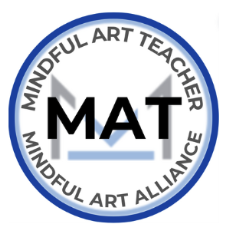
BEGIN YOUR Mindful Art & Sound JOURNEY.
Mindful Meditative ARt
Mindful Meditative Art is a creative form of meditation. Whether you’re an experienced artist, meditator, or have no previous experience this practice is for you! There is no right or wrong way to do it, as it is a way to be in the present moment, notice sensations, thoughts and lean into the mark-making process without judgement rather than focusing on the final product.
Mindful Meditative Art activities sometimes incorporate Expressive Art. Expressive Arts are simple explorations of multiple art forms (which may include imagery, collage, movement, writing, sound, gesture, etc). Mindful Expressive Art can help you de-stress and reconnect with yourself and others in a safe, sacred space. You are invited and encouraged to turn inward and explore creative play. Mindful Expressive Art combines mindfulness and meditative art activities with expressive arts.
Mindful Art is not Art Therapy, the process and work are not used to analyze or diagnose - the relationship is one of guidance for self-exploration, not a therapist/client relationship. For additional support, you may want to work with a therapist.
Sound Journeying
& Vibrational Therapy
Sound journeying involves the use of specific instruments, music, tones, and other sonic vibrations to balance and help the body, mind, and spirit heal itself. A sound guide (sometimes referred to as a sound healer) uses specialized sound frequencies to create a therapeutic atmosphere to promote deep rest, nervous system rebalancing, and emotional release. Ideally, a meditative or theta brainwave state is created which allows access to deeper levels of inner wisdom and healing.
The vibrational frequencies of sound healing instruments like crystal bowls have the ability to move through skin, fluid, and bones of the body, creating full body relaxation and recalibration down to the level of the cellular structure. The experience creates an environment of “resonance” within the body. Many people find that after participating in a sound journey or a vibrational therapy session, they experience an increase in energy, improved mental clarity, increased creativity, and better relationships.
Guided Meditation & VIsualization (Personalized)
Guided meditation is great for those who are new to meditation as it takes the guesswork out of the mechanics of practice. In this form of meditation, the practice is shaped by the guide’s voice (an experienced practitioner). Because the mind has a tendency to wander, most people find it easier to focus and relax when their minds aren’t entirely left to their own devices.
Most styles of guided meditation use an object of focus on which to train the mind, such as breath, mantras, chakras, visualizations and even physical objects. The objective is to notice when the mind has been distracted and return to the object of focus, as a means of cultivating a quieter, more focused state of mind. Some styles also incorporate insight meditation, as a way to reflect on or develop certain qualities.
Guided visualization is a meditation or mindfulness technique where the senses and imagination are engaged to help a person connect with something in their mind. This can include a feeling — such as self-confidence or calmness — a place, an action, or a goal. Just as the body can become tense and stressed in response to thoughts that make a person angry or anxious, it can also become more calm and relaxed in response to calming, peaceful, and pleasant thoughts.
RestorAtive Practices -Community Building & Peer Support CIrcles
Restorative circles include practices that are as old as humanity itself, where people gather together to connect, solve problems, repair harm, and hold space for one another. Circle practices in Western culture are derived from indigenous traditions adapted for the modern context. The container of the circle emphasizes the importance of creating a safe and inclusive environment where participants feel valued and can begin to feel comfortable sharing their experiences and perspectives.
Restorative circles may be utilized in a number of ways, including but not limited to: Building and strengthening relationships and communities. Healing harms and increasing accountability. Fostering connectivity in ways that allow all community members to thrive and feel valued. The circle-keeper is often an equal participant and plays a critical role in maintaining the container, reminding participants to return to shared agreements, and creating an environment where everyone feels heard and respected.
Please note: While healing may occur as a result of participation, circles are not therapy or case management services. A Circle Keeper does not act as a therapist or counselor in their role as Circle Keeper.
MEET YOUR Guide
Amber Vlangas
Certified Mindful and Meditative Art Teacher
Certified Meditation Specialist & Sound Healer/Guide (Group, On-Body One on One, Tuning Forks, Himalayan Bowls)
Restorative Practices Facilitator (with specialization in working with survivors and system-impacted people)
Trained Mediator
Amber has been practicing expressive arts in one way or another her whole life. Her heart for others, belief in the healing power of art, expression and human connection have led her to this work.

"You use a glass mirror to see your face.
You use works of art to see your soul."
George Bernard Shaw







